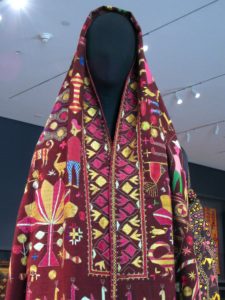
Phulkari.
Phul (pronounced either pool or fool) means flower. I certainly felt that I had stepped into a glorious flower garden when I entered a featured exhibition at the Philadelphia Museum of Art last week (see it through July 9, 2017).
Kari means work, and it’s readily apparent that phulkaris take months or even years to make.
And oh, how richly ornate are these flower works, silk embroidered shawls that are often started upon a daughter’s birth, or stitched by the girl herself, to bring into her husband’s house as an important part of her dowry. Phulkaris are worn draped over head and shoulders by women all over Punjab–the area that straddles Pakistan and India — during marriage festivals and other joyous occasions. They can also serve as bedding and wall hangings. Like quilts!
Phulkaris from the Jill and Sheldon Bonovitz Collection are supplemented by others from the Philadelphia Museum of Art’s collection, and most were created in the early 20th century. In Phulkari embroidery–silk and cotton threads ornament the cloth, usually a handspun, handwoven cotton. Folk art folk and animals seem to be making their way across the shawl, while flowers and geometric forms provide a well-balanced cacophony of figures. It’s fun to imagine the story being told in the stitches.
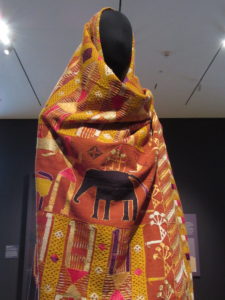
.
We quilt-lovers of quilt history can draw many parallels between the domestic arts of Punjab and of 19th century America. Like quilting, the making of phulkaris was usually done in the home, fulfilled creative urges, and brought color into what may have been a drab day-to-day existence. Both were and are often remain celebrated folk art forms. Check out this appliqued quilt top, below, known as “Bird of Paradise,” made in the Albany NY area between 1858 and 1863, from the collection of the Museum of American Folk Art.
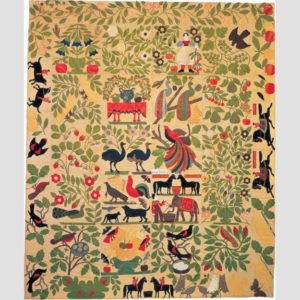
The charming story quilt below was appliqued and tied by a self-taught African-American woman who was born a slave in Georgia. Known as the “Harriet Powers” quilt, it is thought to have been made between 1895 and 1898.
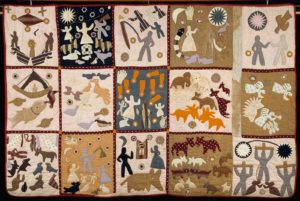
Getting back to punjabi shawls: I love this one below: peacocks strutting, rain falling, plus a floral border with a little section of red, like an error but not, thought to ward off the evil eye. Just like the deliberate mistakes in Amish quilts, because “only God is perfect.”
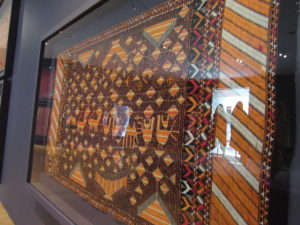
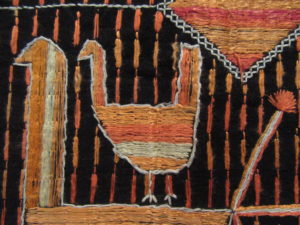
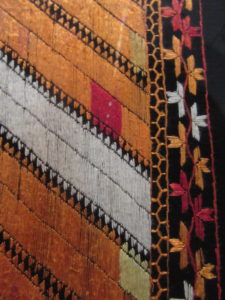
Notice the similarity in pictorials between these eastern and western examples? Many different cultures obviously like to feature images symbolic of marriage, family, fruitfulness/fertility, and home. Art of “just folks.” Folk art.
As mentioned, most phulkaris show the background cloth, much like applique. You would think these birds, horses, and people are done on a background fabric where the warp floats over a few threads to make a sateen textile.
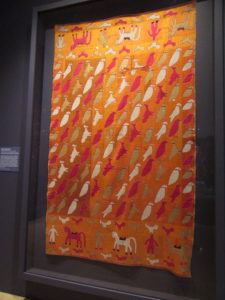
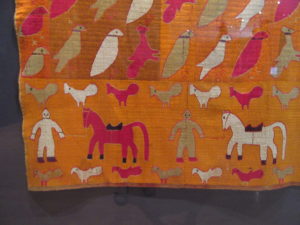
But no, the marigold background is all embroidered. That’s a “bahg” phulkari, embroidery so dense that the base cloth can’t be seen.
Another example is below, with shapes that recall gems, jewelry, and other embellishments. With silk thread from China, these were very costly to make. No wonder then, that the threads are stitched mostly on the front of the cloth.
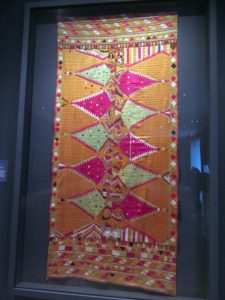
Also on view in this exhibit are a couple of gowns and a man’s jacket created with phulkaris by a famous contemporary designer, Manish Malhotra. I wonder if he was given a hard time for cutting up phulkaris for his posh outfits? One can only hope he used damaged pieces, just as we should only cut up a ragged quilt or fragments to make wearables, pillows, holiday stockings, and bags.
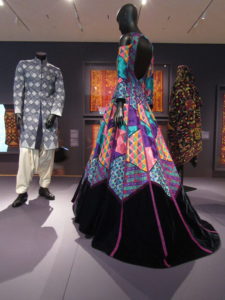
Want to learn more, and see more, about phulkaris? Watch this lovely, informative video produced for the Philadelphia Museum of Art.

